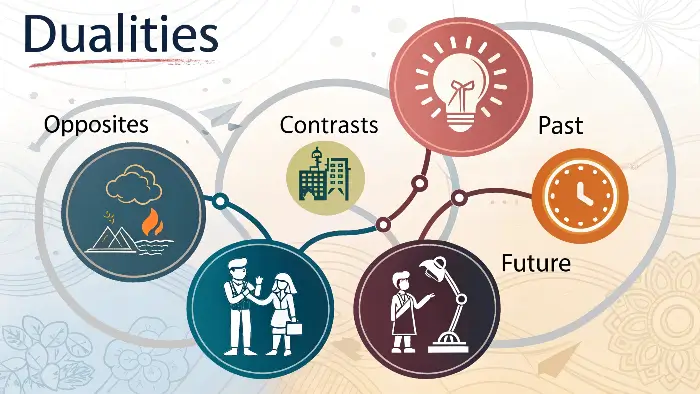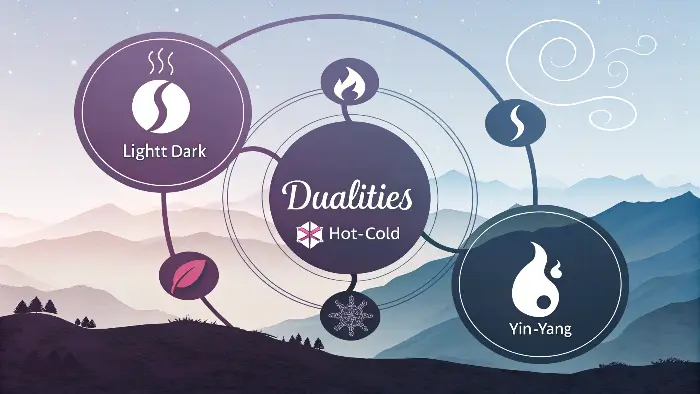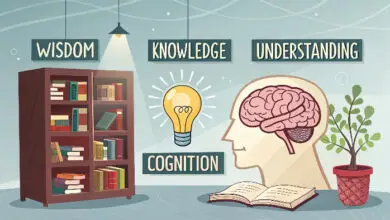Exploring Synonyms for ‘Dualities’ and Their Significance in Various Contexts

Exploring Synonyms for ‘Dualities’ and Their Significance in Various Contexts
The term “dualities” refers to the existence of two contrasting or complementary elements that together create a whole. These elements might be opposites, like light and dark, or they might be complementary, like body and mind. Dualities are pervasive in both philosophical and everyday contexts, helping to frame complex concepts by showing how seemingly opposing ideas can coexist.
In this article, we will explore several synonyms for “dualities” and how their meanings vary depending on the context. By understanding these synonyms, we can better appreciate the subtle differences between the various forms of duality and how they are used to reflect different aspects of human experience, thought, and philosophy.
What Does ‘Duality’ Mean?
Duality comes from the Latin word “dualis,” meaning “two” or “double.” It is often used to describe situations or concepts where two opposing or contrasting elements exist side by side. These elements can be in harmony, conflict, or in a relationship of interdependence. Duality can be used in different contexts such as philosophy, psychology, literature, and even in everyday conversation.
For example:
- “The duality of human nature” refers to the idea that humans can possess both good and bad traits.
- “The duality of light and darkness” is often used to describe the coexistence of opposites in the universe.
The term dualities is typically used when referring to the different forms of two-ness that exist in various phenomena.
Synonyms for ‘Dualities’ and Their Nuances

- Bipolarity
Bipolarity is a synonym for duality that is often used in scientific, political, and psychological contexts. It refers to the presence of two opposing or contrasting forces or concepts, but typically with an emphasis on the distinctiveness of each force. For example, in political science, bipolarity often refers to the distribution of power between two dominant entities, such as the United States and the Soviet Union during the Cold War.
Example:
- “The bipolarity of the political system led to constant tension between the two major parties.”
While duality can refer to any two related aspects, bipolarity has a stronger implication of a system divided into two competing or contrasting poles.
- Contrast
Contrast refers to the difference or opposition between two things. While duality refers to the existence of two related elements, contrast focuses more on highlighting the differences or opposites between those elements. Contrast is often used in discussions of art, philosophy, and aesthetics to point out how two elements are distinct or in opposition.
Example:
- “The contrast between the light and shadow created a dramatic effect in the painting.”
Contrast emphasizes the differences, whereas duality can refer to a balanced coexistence of two elements, whether opposing or complementary.
- Dichotomy
Dichotomy refers to a division into two mutually exclusive or contradictory parts. It is similar to duality, but typically involves a more rigid separation between the two parts. Dichotomy is often used to describe situations where two elements are completely different or in conflict with each other, such as the dichotomy between good and evil, or life and death.
Example:
- “The dichotomy between science and religion has been a long-standing debate.”
While duality suggests that two contrasting forces may coexist or complement each other, dichotomy implies a sharp division or opposition, with little to no overlap.
- Polarities
Polarities is a synonym for dualities that emphasizes the extremes of two opposing forces or qualities. It is often used in contexts where two forces are in direct opposition but are also necessary for balance. Polarities refers to the idea of opposites that are interconnected, like the positive and negative poles of a magnet, or the contrasting forces of love and hate.
Example:
- “The polarities of human emotion—joy and sorrow—are essential to understanding the full human experience.”
While duality refers to the existence of two related forces, polarities emphasizes the extremity and opposition between them.
- Contradictions
Contradictions refer to situations where two things are in direct opposition to each other, typically without the possibility of coexistence or reconciliation. Contradictions highlight a logical or factual inconsistency, and the term is often used in discussions of philosophy, logic, and reasoning.
Example:
- “The contradictions in his argument made it difficult to trust his conclusions.”
Contradictions imply that two things cannot be true at the same time, while dualities suggest that two opposing elements can coexist in a meaningful way.
- Complementarities
Complementarities refer to two elements that, while different, work together to form a whole. In this context, dualities are not just opposites, but elements that complete each other and are interdependent. Complementarities are often used to describe relationships where differences are essential to creating a harmonious balance.
Example:
- “The complementarities between science and technology drive innovation in modern society.”
Complementarities highlights how the two elements are interconnected and enhance one another, while dualities may or may not have this sense of mutual dependence.
- Pairs
Pairs are a more neutral synonym for dualities, referring simply to two things that are grouped together, whether they are similar or different. This term is often used in everyday language and doesn’t necessarily imply any inherent opposition or conflict between the two elements.
Example:
- “The pair of shoes matched perfectly with her dress.”
Unlike dualities, which often imply a deeper, more philosophical relationship between two elements, pairs are simply two items or concepts that are considered together.
- Ambiguities
Ambiguities refer to situations where something has multiple possible meanings or interpretations. While dualities refer to two contrasting elements, ambiguities reflect uncertainty or the presence of multiple conflicting possibilities. Ambiguities arise when it’s unclear how two aspects of something relate to each other.
Example:
- “The ambiguity of the novel’s ending left readers with a sense of uncertainty.”
While dualities suggest a balanced coexistence of two forces, ambiguities imply a lack of clarity or resolution between two potentially conflicting ideas.
- Juxtaposition
Juxtaposition is the act of placing two things side by side to highlight their contrast or relationship. In literature and art, juxtaposition is used to compare and contrast different elements to create a specific effect or meaning. While dualities refer to two elements in relation to each other, juxtaposition emphasizes the placement and comparison of these elements.
Example:
- “The juxtaposition of wealth and poverty in the story highlights the social inequalities of the time.”
While dualities refer to the presence of two contrasting elements, juxtaposition emphasizes the intentional contrast created by placing the two elements side by side.
Conclusion
Understanding the synonyms for ‘dualities’ can help us better navigate discussions where two contrasting or complementary elements are at play. From bipolarity and dichotomy to complementarities and juxtaposition, each synonym offers a unique perspective on how two forces can relate to one another.
By choosing the right word, you can convey subtle nuances in meaning:
- Use contrast and dichotomy when highlighting clear differences.
- Opt for complementarities or juxtaposition when the two elements work together in a meaningful way.
- Choose polarities when emphasizing opposing extremes, and ambiguities when dealing with uncertainty or conflicting interpretations.
Understanding these synonyms allows you to more effectively discuss dualities in various contexts, from philosophy to literature, to the complexities of human nature and experience.







